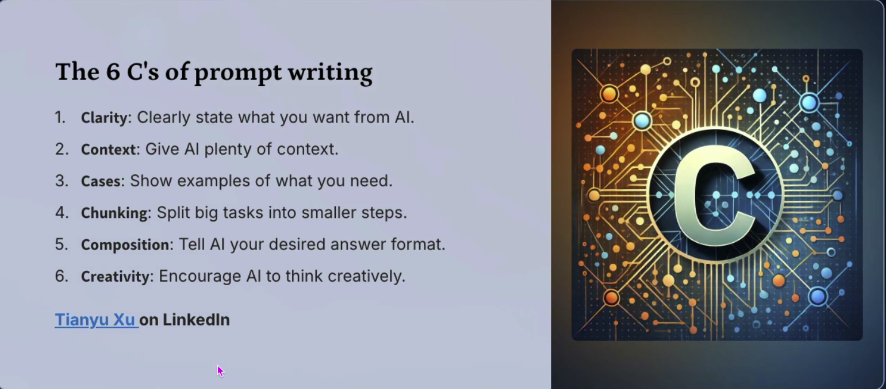
OpenAI Cookbook GPT-5 Prompting Guide - The GPT-5 Prompting Guide is a concise, practical manual that teaches users how to write better prompts to get more accurate, useful, and reliable responses from the model. It's designed to help educators and professionals use AI more effectively in real-world tasks.
Anthropic : Prompt Engineering Overview - The Anthropic Prompt Engineering Overview is a clear, actionable guide that helps users refine prompts to improve Claude’s performance across diverse tasks. It’s built for educators and developers aiming to get more consistent, interpretable, and high-quality results from AI through structured techniques like examples, roles, and chain-of-thought prompting.
Prompt Engineering for ChatGPT - Coursera course by Dr. Jules White, Vanderbilt University.

Getting Started with Prompt Writing - Harvard University has produced this guide to assist with prompt writing.
1. Be Specific
2. "Act as if..."
3. Tell it how you want your output to be presented
4. Use "Do" and "Don't"
5. Use Examples
6. Consider Tone and Audience
7. Build on Previous Prompts
8. Correct Mistakes and Give Feedback
9. Ask it to create your prompts or what else it needs from you.
Developing Effective Text-Based Prompts - University of Alberta has produced this guide to assist with developing effective text-based prompts.
5 Ways to Write Better AI Prompts - Try the techniques listed in this article by Jeremy Caplan to gain responses with different perspectives, bold, fresh and new ideas.
AI systems can sometimes show unfair or biased results based on how we ask them questions. By learning to write clear, neutral prompts, we can help make AI responses more fair and respectful to everyone.
Helping Students Understand the Biases in Generative AI - Take a look at this article from the University of Kansas for more information.
Prompt-to-URL Generator - Turn any prompt into a clickable ChatGPT / Perplexity URL in one step with this generator
Tip: Save a list of useful prompts into a Google Doc for easy access later.
System Prompt is the "behind-the-scenes" prompt that tells the model how to behave. It sets the "personality" and the guardrails for the model.
Anthropic System Prompts - an example of systems prompts used by Anthropic.